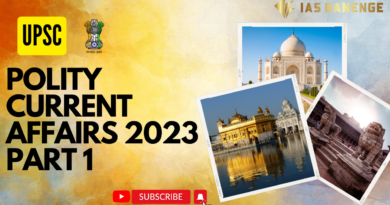Polity and Governance Current Affairs for UPSC 2023 I PART – 7
GOVERNANCE
1.URBAN LOCAL BODIES (ULBS)
“The Delhi Municipal Corporation (Amendment) Act, 2022: Reunifying the Municipal Corporations of Delhi”
The Delhi Municipal Corporation (Amendment) Act 2022 is a law that amends the Delhi Municipal Corporation Act, 1957 to reunify the Municipal Corporation of Delhi (MCD). This amendment effectively undoes the previous 2011 amendment that had trifurcated the MCD into separate Municipal Corporations for North, South, and East Delhi.
The proposal for the split-up was first recommended in the Balakrishnan Committee Report of 1987, which was further supported by the Virendra Prakash Committee Report of 2001.
Under Article 239AA of the Indian Constitution, the Parliament is empowered to legislate on any matter related to the National Capital Territory of Delhi, including subjects on which the Legislative Assembly can make laws.
2.AUDIT OF LOCAL SELF GOVERNMENT
“Comptroller and Auditor General (CAG) to Expand Audit Control Over Three-Tier Panchayati Raj Institutions (PRI) at the District Level”
The Comptroller and Auditor General (CAG) currently has a presence in state capitals, and its accountant general’s office is responsible for auditing the accounts of state governments. The Panchayati Raj Institutions (PRIs) draw funds from separate fund accounts kept in banks or treasuries.
However, the CAG has decided to assert its constitutional mandate to supervise all government expenditure, whether drawn from the consolidated fund or the state treasury, including that of PRIs. PRIs fall under the purview of the audit under the Comptroller and Auditor-General’s (Duties, Powers, and Conditions of Service) Act, 1971.
About Local Self Governance and its Audit
The 73rd and 74th Constitutional Amendments were passed by the Parliament in 1992, mandating the establishment of panchayats and municipalities in every region by the State governments. This created a third tier of governance in the federal framework, with the devolution of functions, funds, and functionaries to local governments.
Constitutional provisions such as Article 243 J empower the Legislature of a State to make provisions regarding the maintenance of accounts by Panchayats and auditing of such accounts, while Article 243 Z enables the Legislature of a State to make provisions regarding the maintenance of accounts by Municipalities and auditing of such accounts.
3.DIGITALISATION OF LAND RECORDS IN INDIA
“Central Government Urges State Governments to Boost Digitalisation of Land Records by Installing Local Servers and Increasing Internet Speed in Sub-Registrar Offices”
The Digital India Land Records Modernization Programme (DILRMP) is a central sector scheme launched by the Ministry of Rural Development in 2016. The programme aims to modernize land records and make them available online.
Under the DILRMP, the government is planning to implement an online registration system. The programme has three major components: computerization of land records, survey/re-survey, and computerization of registration.
How is Land ownership recognised in India?
Land ownership in India is recognized through a set of documents such as Record of rights (RoR), registered sale deed, survey documents, and property tax receipts. To promote digitization, the government has taken various measures such as the National Generic Document Registration System (NGDRS), Unique Land Parcel Identification Number (ULPIN) System, BhuNaksha, and the SVAMITVA scheme. There is also an initiative to transliterate Records of Rights to any of the 22 languages recognized by the Constitution. Several states such as Karnataka and Telangana have also launched their own initiatives to digitize land records.
4.LOCALISATION OF SUSTAINABLE DEVELOPMENT GOALS (SDGS)
Ministry of Panchayati Raj signs joint statement with UNDP on localisation of Sustainable Development Goals (LSDGs)
The Sustainable Development Goals (SDGs) were adopted at the United Nations Sustainable Development Summit in 2015, with a goal to end poverty, fight inequality and injustice, and tackle climate change by 2030. Localisation of SDGs in India is the process of taking into account sub-national contexts in the achievement of SDGs. This includes using SDGs to provide a framework for local development policy and identifying how bottom-up actions from local and regional governments can support SDGs achievement. NITI Aayog is responsible for coordinating the implementation of SDGs in India, overseeing adoption and monitoring of SDGs in the country, and promoting competitive and cooperative federalism among states and UTs. To monitor progress, NITI Aayog launched the annual ‘SDG India Index’ in 2018, which monitors the progress of states and UTs on SDGs and localisation of SDGs through eight steps.
5.SPORTS GOVERNANCE
Bureau of FIFA Council lifts suspension on All India Football Federation (AIFF) after dissolution of Committee of Administrators (CoA) by SC.
The Committee of Administrators (CoA) was appointed by the Supreme Court of India to oversee the affairs of the All India Football Federation (AIFF) and ensure the adoption of its constitution in line with the National Sports Code and Model Guidelines. However, FIFA suspended AIFF due to “undue influence from third parties,” which is a serious violation under FIFA Statutes. The dissolution of CoA was a necessary condition from FIFA to lift AIFF suspension, as it gives AIFF full control over its daily affairs. In India, sports governance and administration are broadly divided into two wings: the Ministry of Youth Affairs and Sports (MYAS) and its subordinate organizations such as the Sports Authority of India (SAI), and sports organizations under the Olympic Charter, such as the Indian Olympic Association (IOA), State Olympic Association (SOA), and National Sports Federation (NSF). For non-Olympic sports such as cricket, the organizations such as the Board of Control for Cricket in India have direct affiliation from respective international federations.
6.RULES FOR RESIGNATION AND REINSTATEMENT OF AN INDIAN ADMINISTRATIVE SERVICE (IAS) OFFICER
In 2019, an IAS officer, who resigned from service has been reinstated.
The resignation of an officer of any of the three All-India Services (IAS, IPS, and Indian Forest Service) is governed by the All India Services (Death-cum-Retirement Benefits (DCRB)) Rules, 1958. Similar rules exist for officers belonging to other central services as well. The central government may permit an officer to withdraw his/her resignation “in the public interest” as per the DCRB Rules (amended in 2011). However, the government shall not accept the request for withdrawal of resignation where the officer is associated with any political parties or any organization which takes part in politics or to take part in, or assist in any other manner, any political movement or political activity or to canvass or use his/her influence in connection with, or take part in, an election to any legislature or local authority. The resignation of an IAS officer must be submitted to the Chief Secretary of the state in case of an officer serving in the state or the Secretary of the concerned Ministry or Department in case of an officer who is on central deputation. The competent authority, i.e., the central government, considers the officer’s resignation only after receiving the recommendation of the concerned cadre/state. The competent authorities are the Minister of State at the Department of Personnel & Training (DoPT) in respect of IAS, the Minister for Home Affairs in respect of IPS, and the Minister for Environment, Forest and Climate Change in respect of Forest Service.
7. NATIONAL STANDARDS FOR CIVIL SERVICE TRAINING INSTITUTIONS (NSCSTI)
Ministry of Personnel Launches National Standards for Civil Service Training Institutions (NSCSTI)
Ministry of Personnel has launched National Standards for Civil Service Training Institutions (NSCSTI), developed at Capacity Building Commission (CBC) headquarters, to create standards for civil service training institutions at a national level. These standards will equip Central Training Institutions (CTIs) to help civil servants tackle emerging challenges of the 21st century. The objectives of NSCSTI are to create a baseline for CTIs, harmonize standards for training, and set aspirations for training institutions to strive towards excellence.
Initiatives taken to improve functioning of civil servants
The Indian government has launched several initiatives to improve civil service training and development. Mission Karamyogi is an online platform for continuous training of government servants, while Aarambh is a common foundation course for civil servants. The National Training Policy, adopted in 1996 and reviewed in 2012, aims to develop a professional, impartial, and efficient civil service that is responsible to citizens’ needs. Lateral entry is another initiative that allows direct induction of domain experts at the middle or senior levels of administrative hierarchy.
TO THE POINT
1.Revamped probity portal has been launched by Department of Personnel and Training (DoPT).The Probity Portal (PP) was introduced in 2017 to gather data from various government bodies on issues such as pending cases for sanction of prosecution, implementation of rotational transfer policy, and number of penalty disciplinary proceedings. Recently, the Department of Personnel and Training (DoPT) has updated the portal to enhance its functionality and improve the user experience. The revamped portal now offers additional features that aim to make the data collection process more efficient and user-friendly.
2.“MeghEA’s E-Proposal System Receives 2022 UN World Summit on Information Society Forum WSIS Award”.The MeghEA project, initiated by the Ministry of Electronics and Information Technology, aims to leverage digital technologies to enhance service delivery and governance for the people of Meghalaya. The project is unique in that it is based on India’s National Enterprise Architecture framework and envisions making Meghalaya a high-income state by 2030. This innovative initiative is the first of its kind in India and aims to create a more efficient and effective government system by leveraging the power of technology.
3.“India Scores ‘Much Below’ Its Peers on All Counts in World Bank’s WGI Analysis, A Key Input for Sovereign Ratings”.The World Bank’s WGI reports provide governance indicators for over 200 countries and territories from 1996 to 2020. The WGI is based on six dimensions of governance, which are derived from a combination of views expressed by a large number of enterprise, citizen, and expert survey respondents from both industrial and developing countries. These indicators provide a comprehensive overview of the state of governance across various countries and are an essential input for determining sovereign ratings.
4.World Press Freedom Index (WPFI), 2022.The Reporters Without Borders (RSF), a non-profit organization, publishes an annual World Press Freedom Index that ranks countries based on the degree of freedom that journalists, news organizations, and netizens have, and the government’s efforts to respect such freedom. The rankings are based on a score ranging from 0 to 100, with 100 being the best possible score (highest possible level of press freedom) and 0 the worst. The evaluation criteria include five indicators: political context, legal framework, economic context, sociocultural context, and safety. India slipped 8 places to 150 in the 2022 World Press Freedom Index from last year’s 142nd rank out of 180 countries, according to the RSF report.
5.E-Government Survey 2022.The United Nations Department of Economic and Social Affairs recently released the “E-Government Survey 2022: The Future of Digital Government” that assesses the digital government landscape across all 193 member states. According to the report, India has ranked 105th in the E-Government Development Index and 61st in the E-Participation Index, down from its 2020 ranking of 100 and 29 respectively. Meanwhile, Denmark has been ranked first in the E-Government Development Index, while Japan has topped the E-Participation Index.
6.Rule of Law Index.The Indian government has turned its attention to improving its ranking in the Rule of Law Index, which is published by the US-based civil society group, World Justice Project (WJP). In the 2022 rankings, India was placed 77th out of 140 countries. The Rule of Law Index measures eight factors, including the constraint on government powers, absence of corruption, open government, fundamental rights, order and security, regulatory enforcement, civil justice, and criminal justice. By focusing on improving its ranking in this index, India aims to enhance the rule of law and create a more transparent and fair legal system.
7.National EGovernance Services Limited (NeSL).NeSL, India’s first Information Utility, has processed one million transactions through its digital document execution platform. Registered with the Insolvency and Bankruptcy Board of India (IBBI) under the Insolvency and Bankruptcy Code (IBC), 2016, NeSL primarily serves as a repository of legal evidence holding information pertaining to any debt or claim. Its role is to provide a secure and reliable digital platform for debtors and creditors to execute and record agreements, thereby facilitating the resolution of disputes and ensuring the timely recovery of debts.





Pingback: Economics Current Affairs for UPSC 2023 I PART -4 - Ias Banenge